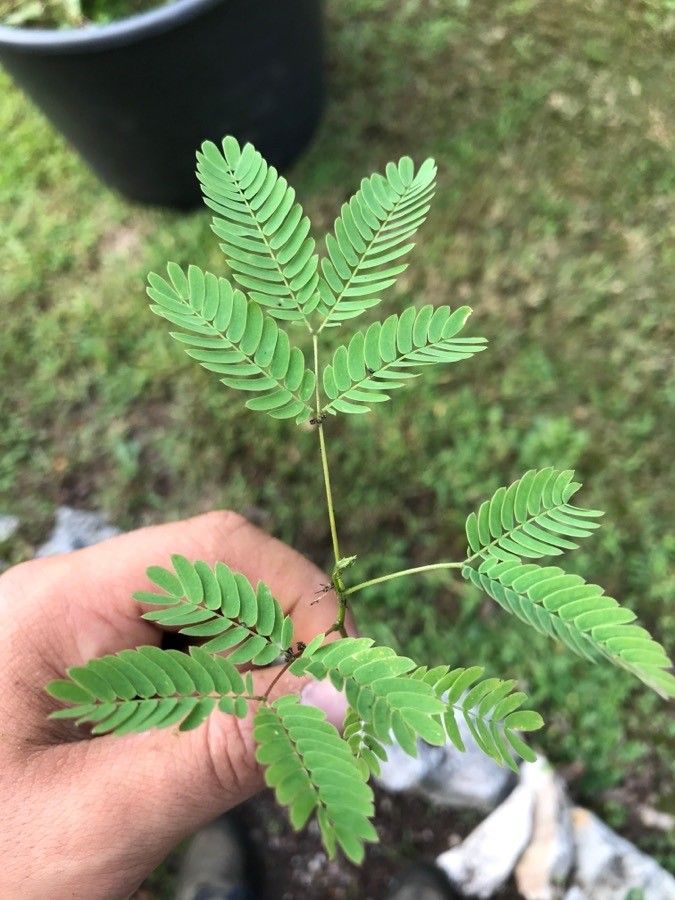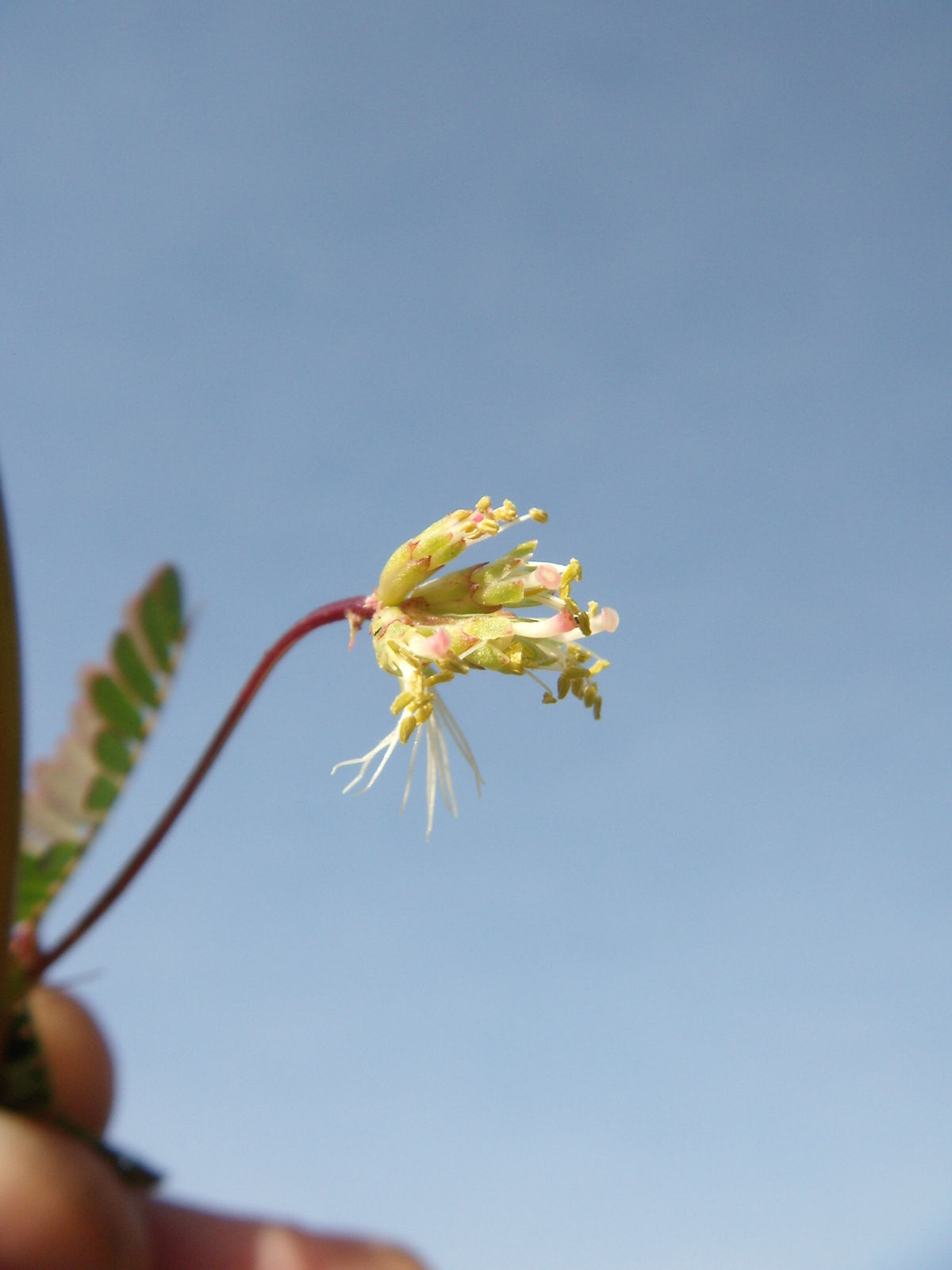Whip Thorn, Whiptail Mimosa, Catclaw Mimosa
desmanthus virgatus
Also known as: ["Whip Thorn","Whiptail Mimosa","Catclaw Mimosa"]
Overview
A deciduous shrub native to tropical and subtropical regions, known for its feathery foliage and spiny stems.
Benefits & Perks
["drought tolerant","wildlife attractant (bees, butterflies, birds)"]
Botanical Classification
| Phylum: | Magnoliophyta |
| Class: | Magnoliopsida |
| Order: | Fabales |
| Family: | Fabaceae |
| Genus: | Desmanthus |
| Botanical Name: | Desmanthus virgatus |
Plant Characteristics
Basic Information
- Category: Shrubs
- Suitable Location: shaded garden bed or container in a protected area
- Suitable For:
- Is Weed: No
- Allergenicity: low
Environmental Needs
- Climate: {"temperatureRange":"10–30°C"}
- Hardiness: {"zones":"8–11"}
- Misting: every 2–3 days in dry climates, rarely needed in humid environments
- Drainage: Fast-draining to prevent root rot.
- Soil Type: Well-draining, loamy soil with organic matter; tolerates poor soils but thrives with amendments.
Maintenance Level
- Maintenance Level: moderate
- Toughness Level: high
- Pruning Frequency: Annually in late winter or early spring; light pruning can be done as needed year-round.
- Pruning Intensity: Moderate; remove up to one-third of growth if overgrown, otherwise selective trimming.
Care Details
Ideal Sunlight Coverage:
Full sun (6–8 hours/day) with tolerance to partial shade; adjust exposure based on seasonal intensity.
Sunlight Tolerance Tips:
Acclimate plants gradually to intense sunlight; protect from harsh midday sun in summer; ensure adequate light indoors with supplemental grow lights if needed.
Care Requirements
Care Difficulty
moderatemoderate
Sunlight
partial shade to full shade
Rotate plant weekly for even growth; use sheer curtains to filter intense light; avoid sudden light changes.
Watering
every 7–10 days during active growth, reduce in winter
Water thoroughly until runoff, allow soil to dry partially between waterings, and avoid frequent shallow watering.
Soil
moist, well-drained, rich in organic matter
pH: Slightly acidic to neutral (6.0–7.0).
Avoid heavy clay soils; ensure consistent moisture without waterlogging; test pH annually.
Temperature
Thrives in 70–95°F (21–35°C); tolerates mild frosts but prefers warm conditions; adjust care for seasonal fluctuations.
Monitor temperature extremes; use thermal mass to stabilize microclimate; adjust watering for heat/cold.
Fertilizing
every 4–6 weeks during growing season, none in winter
Apply fertilizer after watering to prevent root burn; use organic options like compost tea for gentle feeding; flush soil occasionally to prevent salt buildup.
Propagation
Methods
Stem cuttings or seed; cuttings root readily in warm conditions.
Step-by-Step Propagation Guide
- Take 4–6 inch cuttings.
- Remove lower leaves.
- Dip in rooting hormone.
- Plant in medium.
- Maintain humidity.
Best Time: Spring or early summer when temperatures are warm and humidity is moderate.
Environment
High humidity (70–80%), warm temperatures (75–85°F), and indirect light.
Medium
Well-draining mix of perlite and peat moss or cactus soil.
Hormone
Rooting hormone recommended for faster and more reliable rooting.
Timeline
Roots develop in 3–6 weeks; establish in new pot within 2–3 months.
Tools Needed
Pruning shears, rooting hormone, small pots, misting bottle, plastic wrap.
Quick Tips
Use healthy, non-flowering stems; keep medium consistently moist but not waterlogged; provide bottom heat if possible.
Pruning & Repotting
Pruning Guide
Method
Thinning cuts to open canopy; heading back to encourage branching; clean cuts to avoid damage.
Pruning Plan
Shape plant for airflow and light penetration; remove dead or diseased growth; encourage bushier habit.
Tools
Pruning shears, loppers, sterilizing solution, gloves.
Checklist
Sterilize tools; prune during dormancy; make clean cuts; dispose of debris properly.
Repotting Guide
Best Season
Early spring before active growth begins.
Pot Size
Increase pot size by 2–3 inches in diameter; ensure drainage holes.
Method
Remove plant gently; trim roots if necessary; place in new pot with fresh soil; water lightly.
Suggestions
Repot every 2–3 years or when roots fill container; beneficial for nutrient replenishment and growth space.
Checklist
Choose appropriate pot; prepare fresh soil mix; handle roots carefully; water after repotting.
Advanced Care Tips
Watering Mastery
Watering Checklist
Check soil moisture with finger; water deeply; ensure drainage; adjust frequency seasonally.
How to Apply Water Properly
Water directly at the root zone, apply until water drains from the bottom, ensure even saturation, and water early in the morning or late evening to minimize evaporation.
Watering Schedule Tips
Water deeply once every 7–10 days during active growth; reduce frequency to every 2–3 weeks in winter or drought; adjust based on rainfall and soil moisture retention.
Soil Improvement
Add perlite or coarse sand for drainage; incorporate compost for fertility; use mulch to retain moisture.
Temperature Stress Management
Signs of Temperature Issues
Chlorosis or necrosis in extreme heat; stunted growth or leaf drop in cold stress; wilting in temperature shock.
Cold Stress
Growth slows or halts; roots may become susceptible to rot; leaves may turn yellow or brown.
Solution: Move to a warmer location; apply a thick mulch layer; protect from drafts and frost.
Hot Stress
Wilting despite moist soil; leaf scorch or curling; reduced flowering or pod production.
Solution: Provide shade during peak heat; increase watering frequency; use evaporative cooling methods like misting.
Fertilizing Guide
Fertilizing Checklist
Check fertilizer type; follow dilution instructions; apply during active growth; avoid over-fertilization.
Fertilizing Method
Use balanced, slow-release fertilizer in spring/summer; dilute liquid fertilizer to half-strength monthly; avoid feeding in winter.
Common Problems & Solutions
Toxicity Warning
Cats
Non-toxicDesmanthus virgatus is not known to be toxic to cats. There are no reported cases of adverse effects in felines from exposure to this plant.
⚡ Toxic If:
None
Dogs
Non-toxicDesmanthus virgatus is not known to be toxic to dogs. There are no reported cases of adverse effects in canines from exposure to this plant.
⚡ Toxic If:
None
Humans
Non-toxicDesmanthus virgatus is not known to exhibit toxic properties to humans under normal conditions. It is generally considered safe for human contact and consumption.
⚡ Toxic If:
None
Frequently Asked Questions
Q: Is Desmanthus virgatus toxic to pets?
A: There is no reliable information available regarding its toxicity to pets.
Q: How often should Desmanthus virgatus be watered?
A: It is drought-tolerant and requires minimal watering once established.
Q: Does Desmanthus virgatus attract wildlife?
A: Yes, it attracts bees, butterflies, and birds due to its nectar-rich flowers.
Quick Reference
| Family: | Fabaceae |
| Care: | moderate |
| Light: | partial shade to full shade |
| Water: | every 7–10 days during activ |
Get Expert Care Tips
Download the Plantious app for personalized care reminders and plant identification!
Google Play App Store








